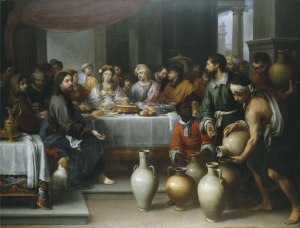With Elizabeth we marvel, “And why is this granted me,
that the mother of my Lord should come to me?” (CCC 2677).
She Who Must Be Obeyed
When I can’t sleep, my go-to is P.G. Wodehouse. I’ve read and re-read the dozen or so Jeeves and Wooster novels scattered around our house countless times, not to mention the ones I’ve checked out from the public library. They’re literary comfort food, and intrinsically peaceful. Nobody gets killed; happy endings are inevitable; and Bertie’s quirks mirror my own quirks – like therapy and sleep aid rolled into one!
Hence, the other night, probably around 2 a.m. or so, I ambled downstairs to the living room to track one down. In the dim light, I grabbed a volume with that familiar orange spine and Penguin trademark, but – alas! – it wasn’t Wodehouse. Instead, it was Rumpole of the Bailey, a book adaptation of John Mortimer’s British TV series that I must’ve snagged from my brother some years ago.
I gave it a glance: “Rumpole is worthy to join the great gallery of English oddballs,” reads the blurb from the Sunday Times, “ranging from Pickwick to Sherlock Holmes, Jeeves and Bertie Wooster.”
“Hmmph,” I grunted to myself sleepily, “we’ll see about that.” I headed back upstairs to bed.
Horace Rumpole is a criminal defense attorney – a “barrister at law” in British parlance – and an irascible character who quotes poetry, enjoys his tobacco and red wine, and never surrenders in the courtroom. Also, he’s the father of one son, Nicholas, and the husband of one wife, Hilda – whom he refers to as “She who must be obeyed.”
Apparently, that’s a title that Rumpole borrows from a popular Victorian novel entitled She, by H. Rider Haggard. In that case, the epithet applied to the novel’s eponymous “she,” a tyrannical African queen – which gives you some idea as to why Rumpole applies it to his spouse. Hilda Rumpole is, shall we say, a formidable woman who generally gets her way, and the banter between Mr. and Mrs. Rumpole provides for some genial moments in the novel.
As I read and nodded, and the words “she who must be obeyed” danced in my drowsy consciousness, a thought jostled me awake: That title meant pejoratively in Hilda’s case could easily be applied in a more positive sense to our Blessed Lady.
For isn’t it practically a direct import of John’s commentary on the wedding at Cana? We see Mary implicitly telling Jesus what to do (“They have no wine”), and Jesus, after objecting to the mandate (“O woman, what have you to do with me?”), extravagantly carrying it out. It’s a picture of Jesus deferring to Mary as “she who must be obeyed” – we should do likewise.
“A-ha!” my Protestant friends will object. “It’s just as we thought: You Catholics treat Mary as if she were a goddess!”
Not at all, I’d argue, and a further look at John’s depiction of the Cana story provides the necessary clarification.
Once Jesus acquiesces to Mary’s request, she then immediately turns to the household servants and gives them a very direct order: “Do whatever he tells you.” It’s the same order that Mary has been giving her spiritual sons and daughters ever since, for two thousand years. Unlike the servants at Cana, who snapped to it and obtained the jugs required for the Lord’s water-to-wine miracle, we drag our feet and falter and forget…and Mary has to remind us again and again: “Do whatever he tells you!”
Oremus, Orans, and Acolytes
This is the season at our parish when the sixth-graders are training to serve at altar. They’re generally short of stature, and I have to admit it’s fun to see them swimming in their albs as they meander about the sanctuary, trying to remember where to go, what to do. (Believe me, I’m sympathetic!)
Seeing them recently, it reminded me of when a friend pointed out that my diminutive daughter could hardly hold up the censer (or ‘thurible‘) – that mini metal stove used for burning incense during the liturgy. It hangs from a chain, and one of the duties of the designated acolyte (or, “thurifer” as she’d be called) is to suspend it in front of the priest so that he can spoon in an adequate amount of fuel.
The thurible can be weighty, sure – but not that weighty, as I assured my friend. Besides, the altar servers only have to hold it up to the priest briefly – along with the short ritual when they’re sent forward with the smoky bowl to incense the congregation: a few short swings to and fro, back and forth – a cinch!
But what about holding up the sacramentary during the collect? That’s got to be another matter altogether, because, unlike the incense gadget, the sacramentaryis an uncommonly big book – dense, oversized, and heavy!
It’s because of the liturgical “orans” (or orantes) posture that the altar servers have to heft this weighty book during the Mass. Just before the opening prayer of each Mass (the “collect”), the priest intones the oremus – the formula “let us pray” with his hands folded. Then, as he recites the collect, he spreads his hands apart with palms upraised – the orans stance of pleading that figures prominently in Catacomb illustrations and other ancient Christian drawings.
The orans tradition can tolerate a number of legitimate interpretations, but the way it’s used today is pretty clear. “The liturgical use of this position by the priest is spelled out in the rubrics (the laws governing how the Mass is said),” writesColin Donovan. “It indicates his praying on behalf of us, acting as alter Christus, as pastor of the flock, head of the body.”
Thus, we can see how vital the acolyte’s humble duty becomes at this point. By holding aloft the sacramentary, the server frees up the priest’s hands to intercede for the congregation. This is in keeping with the instructions we find in the General Instruction on the Roman Missal:
189. Through the entire celebration, the acolyte is to approach the priest or the deacon, whenever necessary, in order to present the book to them and to assist them in any other way required. Thus it is appropriate, insofar as possible, that the acolyte occupy a place from which he can conveniently carry out his ministry either at the chair or at the altar.
It strikes me that this is also an apt description of Mary’s subservient, yet essential, role in God’s plan: to assist her divine son in any way required, and to stay close to him so as to always be available. Mary herself spelled these ideas out in her Fiat (“Let it be to me according to your word”) and Magnificat (“My soul proclaims the greatness of the Lord, my spirit rejoices in God my Savior”).
Summary
- Mary is “she who must be obeyed,” and she commands us to “do whatever he tells you.”
- Mary, the first altar server, models for us that “whatever” in staying close by the High Priest and facilitating his salvific actions in any way she can.
Shouldn’t we do likewise?
October is dedicated to Mary and the Rosary. Let’s see…where are my beads…. It’s the least I could do.
Photo by Anuja Mary Tilj on Unsplash














